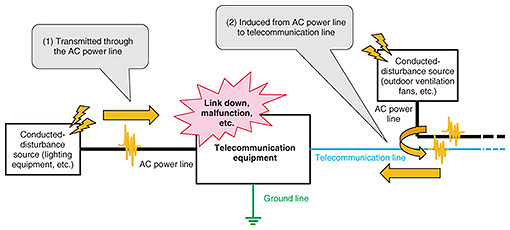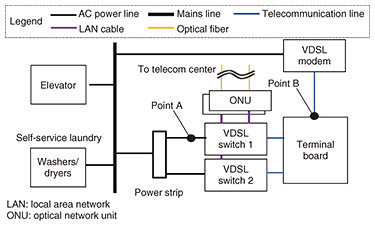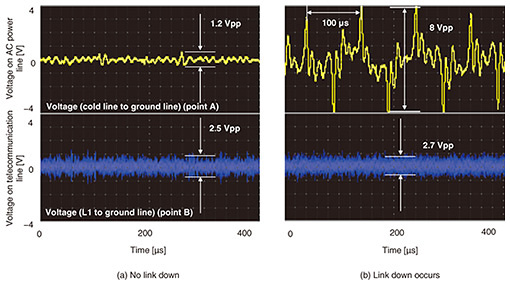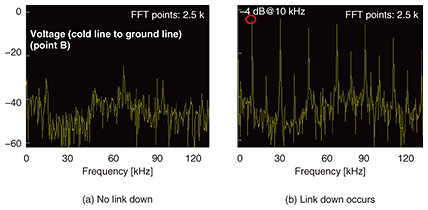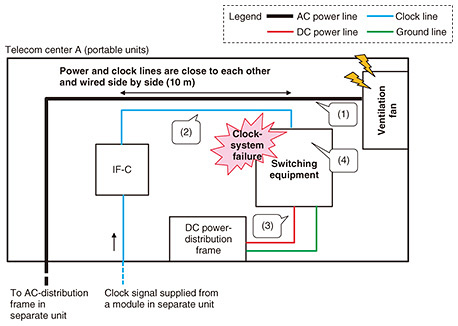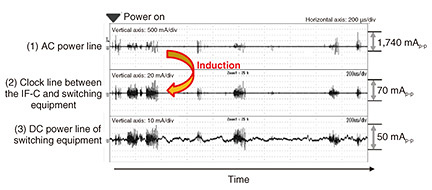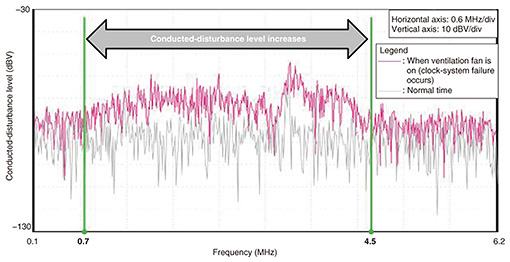 |
|
|
|
|
|
Practical Field Information about Telecommunication Technologies Vol. 22, No. 6, pp. 65–70, June 2024. https://doi.org/10.53829/ntr202406pf1 Case Studies of Telecommunication Problems Caused by Conducted Disturbance in AC Power LinesAbstractThis article describes the mechanism of telecommunication problems caused by conducted disturbance in AC (alternating current) power lines and case studies of troubleshooting investigated by the Technical Assistance and Support Center, NTT EAST. This is the eighty-second article in a series on telecommunication technologies. Keywords: conducted disturbance, noise filter, fast Fourier transform 1. IntroductionA common telecommunication problem that occurs in the customer environment or telecommunication center (telecom center) is malfunctions caused by conducted disturbance generated from alternating current (AC)-power-line-connected equipment. The generation mechanism of conducted disturbance in AC power lines includes deterioration and malfunctions of equipment such as lighting and home appliances. Such conducted disturbance can be transmitted to telecommunication equipment connected to the same AC power line directly or induced into telecommunication equipment through telecommunication lines. In telecom centers, conducted disturbances in AC power lines can infiltrate telecommunication equipment and cause audible noise on analog telephone lines, telecommunication failure, and equipment alarms. This article describes the telecommunication problems caused by conducted disturbance in AC power lines and case studies of troubleshooting investigated by the Technical Assistance and Support Center (TASC), NTT EAST. 2. Mechanism and countermeasures of telecommunication problems caused by conducted disturbance in AC power linesConducted disturbance in AC power lines can infiltrate telecommunication equipment through AC power lines and telecommunication lines. As shown in Fig. 1, conducted disturbance in AC power lines can infiltrate telecommunication equipment through two paths: (1) direct transmission through the power line of the telecommunication equipment and (2) induction from another (nearby) power line into the telecommunication line.
There are two major effects of conducted disturbance in AC power lines on telecommunication equipment. One is that conducted disturbance interferes with telecommunication signals, which causes audible noise, bit errors, link downs, etc. The other is that conducted disturbance interferes with the current flow of internal circuit wiring of the telecommunication equipment, which causes malfunction such as emergency stop or power off operation. To prevent these problems, it is crucial to identify and eliminate the source of conducted disturbance. If the identification or elimination is difficult, it is necessary to reduce the conducted-disturbance level by installing noise filters or other countermeasures in the interference path. 3. Case study 1: Link down of VDSL switch due to conducted disturbance emitted by a washer/dryer3.1 Overview of problemSome customers who use very high-bit-rate digital subscriber lines (VDSLs) in their apartment building reported that they cannot use the Internet during the daytime. Local maintenance staff found that multiple ports of their VDSL switch were frequently linked down (particularly in the morning and evening). Since the cause of the problem was unclear, TASC was asked to investigate the cause and suggest countermeasures. 3.2 Equipment configuration and details and results of investigationThe configuration of equipment in the apartment building is shown in Fig. 2. Two VDSL switches are connected to the same AC power line, and telecommunication lines are wired from the VDSL switches through the terminal board to the VDSL modem. The elevator and washers/dryers located in a self-service laundry annexed to the first floor of the building shared the same AC power-distribution system with the VDSL switches.
To confirm the conducted disturbance interfering with the VDSL switches, we used an oscilloscope (DLM4058 from Yokogawa Electric) to measure the voltage between the cold line of the AC power line and ground line of VDSL switch 1 (Point A in Fig. 2) and the voltage between L1 on the telecommunication line and the ground line (Point B in Fig. 2). We found conducted disturbance up to 8 Vpp on the AC power line when the link down occurred (Fig. 3). However, no obvious conducted disturbance on the telecommunication line was found. When the measured conducted disturbance was subjected to fast Fourier transform (FFT) processing, a fundamental frequency of 10 kHz (red circle in Fig. 4) and its harmonics were observed. The fundamental frequency and third harmonic had the highest conducted-disturbance level, i.e., −4 dBV.
Since we confirmed that conducted disturbance was interfering with the VDSL switches, we investigated the source of the disturbance by focusing on the elevator and washers/dryers installed in the laundry, which share the same AC power line with the VDSL switches. However, we could not conduct measurements in the power-supply control room, so we operated the elevator and washers/dryers and investigated the generation of conducted disturbance at point B in Fig. 2. We first operated the elevator up and down several times but detected no conducted disturbance. We then operated multiple washers/dryers in the laundry and detected conducted disturbance. By turning each washer/dryer individually, we confirmed conducted disturbance when one large washer/dryer was operating (when the motor was running) and all ports of the VDSL switches exhibited a link down. 3.3 Cause and countermeasuresThe results of the investigation suggested that the link down was caused by conducted disturbance of 10 kHz generated from one large washer/dryer, which was interfering with the VDSL switches through the AC power lines. As a countermeasure, it is necessary to inspect and repair the washer/dryer, which is the source of conducted disturbance. To suppress the impact of conducted disturbance during the investigation period, however, we implemented a countermeasure using noise filters for VDSL switch 1 and investigated its effectiveness. We tested two different noise filters for AC power lines (NCT-i3 from DENKENSEIKI Research Institute and CNF-5A from SANRITZ ELECTRONICS), each was installed on the AC power line (at point A in Fig. 2) in separate tests when the washer/dryer was operated for 20 minutes. We confirmed that the link down did not occur in VDSL switch 1 regardless of which filter was installed. 4. Case study 2: Clock-system failure of switching equipment caused by conducted disturbance emitted from a ventilation fan4.1 Overview of problemA clock-system failure (a malfunction detected in a clock signal) occurred in switching equipment installed in telecom center A. The local maintenance staff found that when they turned the ventilation fan on or off, the same malfunction occurred. Since the cause of the malfunction was unclear, TASC was asked to investigate the cause and suggest countermeasures. 4.2 Configuration of equipment and details and results of investigationThe configuration of the equipment in telecom center A is shown in Fig. 5. Telecom center A consists of multiple units, and the switching equipment was supplied with a clock signal via a lightning-protection isolation filter (IF-C) from a clock-supply module installed in a different unit of telecom center A.
The ventilation fan was installed in the same unit as the switching equipment and supplied with AC power from another unit. The clock line from the IF-C to the switching equipment was wired closely to the AC power line of the ventilation fan for about 10 m. To investigate the correlation between clock-system failure and conducted disturbance when the power of the ventilation fan is turned on or off, we used an oscilloscope (DLM4058 from Yokogawa Electric) to measure the current in three locations: (1) the AC power line connected to the ventilation fan, (2) the clock line from the IF-C to the switching equipment, and (3) the direct current (DC) power line of the switching equipment. The measurement results are shown in Fig. 6. When the ventilation fan was turned on, conducted disturbance of 1740 mApp was generated on the AC power line (1). In synchronization with that conducted disturbance on the AC power line, conducted disturbances of 70 mApp on the clock line (2) and 50 mApp on the DC power line (3) were also measured.
The analysis results of applying FFT processing to the measurement (2) are shown in Fig. 7. These results indicate that the conducted-disturbance level increased in the 0.7–4.5-MHz range.
4.3 Cause and countermeasuresFrom the investigation results, it was found that the clock-system failure was caused by conducted disturbance from the ventilation fan, which was propagated through the AC power line and induced into the clock line. As a countermeasure, it is necessary to eliminate the effect of the induction of conducted disturbance by re-routing the clock line. However, it was not possible to reroute the clock line during the investigation period; therefore, we installed a noise filter on AC power lines (GT-215J from KEMET) between the ventilation fan and AC power line and a ferrite core (E04SRM from SEIWA ELECTRIC) on the clock line. We confirmed that the clock-system failure no longer occurred when the ventilation fan was turned on or off. 5. ConclusionThe mechanism of telecommunication problems caused by conducted disturbance in AC power lines and two case studies of troubleshooting investigated by TASC were described in this article. Equipment connected to AC power lines, such as lighting equipment and home appliances, become sources of conducted disturbance as they deteriorate over time or break down, and may adversely affect telecommunication equipment. It is therefore important to inspect and repair such equipment or take countermeasures with noise filters. Even if metal-cable sections will be converted to optical cables in the future, interference of conducted disturbance from AC power lines still may affect optical network units, home gateways, etc. At TASC, we will continue to reduce maintenance operation in the field by providing the knowledge we have accumulated. To reduce telecommunication problems caused by electromagnetic disturbance, radio waves, induction, lightning, and other factors and improve the reliability of telecommunication services, the EMC Engineering Group in TASC will continue to engage in technical cooperation, development, and dissemination of technology through technical seminars and other activities. |

